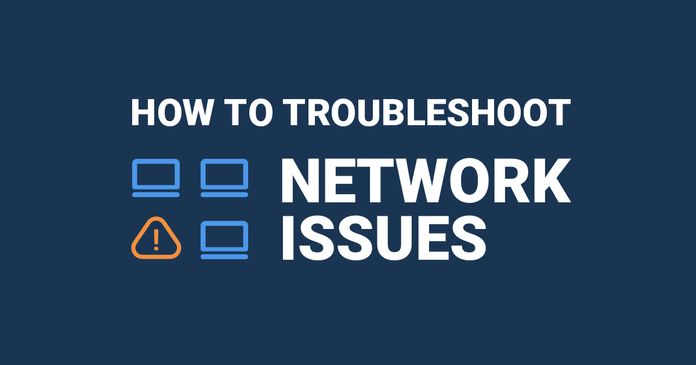Table of Contents
Table of Contents
In today's hyperconnected world, where businesses rely heavily on seamless digital communication and data transfer, network performance has become a critical factor in ensuring optimal productivity and user satisfaction. Whether you're a small enterprise or a large organization, the performance of your network infrastructure can make or break your success.
In this article, we will embark on a journey through the world of network performance testing, exploring its significance, methodologies, and best practices. Join us as we unravel the complexities of assessing, analyzing, and optimizing network performance to pave the way toward peak performance.
Throughout this post, we will dive into the key aspects of network performance testing, shedding light on its importance in detecting bottlenecks, evaluating system stability, and maximizing throughput. We will discuss the various tools and techniques available to measure network performance and delve into strategies that can enhance reliability, scalability, and overall efficiency.
Whether you're a network administrator, an IT professional, or someone seeking to understand the intricacies of network performance, this article aims to equip you with the knowledge and insights necessary to navigate the path to peak performance. From testing methodologies to actionable tips, we've got you covered.
So, if you're ready to unlock the potential of your network infrastructure, fasten your seatbelt and join us as we embark on an exploration of network performance testing and discover the roadmap to achieving network excellence. Let's dive in!
Network performance testing is the process of evaluating and measuring the performance, reliability, and efficiency of a computer network. It involves conducting a series of tests and simulations to assess various aspects of network performance, such as bandwidth, latency, throughput, packet loss, and response time.
The primary objective of network performance testing is to ensure that a network infrastructure is capable of meeting the desired performance standards and requirements. By conducting these tests, organizations can identify potential bottlenecks, vulnerabilities, and areas for improvement within their network environment.
Network performance testing involves the use of specialized tools and methodologies to generate simulated network traffic and measure how the network handles that traffic under different conditions. It helps determine the network's capacity to handle data loads, the impact of network congestion, and the ability to deliver a consistent and reliable user experience.
By conducting network performance testing, organizations can proactively identify and resolve issues that may impact the network's speed, stability, and overall performance. It enables them to optimize their network infrastructure, improve user experience, and ensure that their network can handle the demands of their applications and services.
There are several common types of network performance testing that organizations use to evaluate and assess the performance of their networks. These tests help measure various aspects of network performance and identify potential issues or areas for improvement. Here are some of the most common types:
- Bandwidth Testing: This test measures the available bandwidth of a network connection. It helps determine how much data can be transmitted over the network within a specific time frame. Bandwidth testing is crucial for understanding the network's capacity and ensuring it can handle the required data load.
- Latency Testing: Latency refers to the delay or time it takes for data packets to travel from the source to the destination. Latency testing measures the round-trip time (RTT) between two points on the network, typically in milliseconds. It helps assess the responsiveness of the network and is particularly important for real-time applications like VoIP (Voice over Internet Protocol) or video conferencing.
- Throughput Testing: Network Throughput testing evaluates the network's capacity to handle a certain volume of data within a specific time period. It measures the data transfer rate and helps identify any limitations or bottlenecks in the network. Throughput testing is crucial for understanding the network's performance capabilities and ensuring it can support the required data-intensive applications.
- Packet Loss Testing: Packet loss occurs when data packets get lost or discarded during transmission. Packet loss testing measures the percentage of lost packets and helps identify potential network issues, such as congestion, network overload, faulty hardware, or configuration problems. Minimizing packet loss is essential for maintaining data integrity and overall network performance.
- Jitter Testing: Jitter refers to the variation in latency or delay between data packets. It can impact the quality of real-time applications, causing disruptions or inconsistencies in audio or video transmission. Jitter testing measures the variation in latency and helps assess the network's ability to deliver consistent and smooth data streams.
- Stress Testing: Stress testing involves subjecting the network to high levels of traffic or load to evaluate its performance under extreme conditions. This test helps identify performance bottlenecks, scalability limitations, and the network's breaking points. Stress testing is essential for determining the network's resilience and ensuring it can handle peak traffic without significant degradation in performance.
- Quality of Service (QoS) Testing: QoS testing assesses the network's ability to prioritize different types of data traffic based on predefined quality standards. It ensures that critical applications, such as voice or video, receive the necessary bandwidth and latency requirements for optimal performance. QoS testing helps maintain a consistent user experience and can involve testing parameters like packet prioritization, traffic shaping, and bandwidth allocation.
By conducting these types of network performance tests, organizations can gain insights into their network's capabilities, identify weaknesses, and take proactive steps to optimize performance, enhance user experience, and maintain a reliable and efficient network infrastructure.
And, you don't have to run these network performance tests manually, because there's specialized software to help you do it!
Ready to take your network performance to the next level? Try Obkio's Network Performance Monitoring tool for comprehensive and hassle-free network performance testing. With its powerful features and intuitive interface, Obkio is your go-to solution for optimizing network performance.

And experience the difference!
- 14-day free trial of all premium features
- Deploy in just 10 minutes
- Monitor performance in all key network locations
- Measure real-time network metrics
- Identify and troubleshoot live network problems

Think of network performance testing as the spandex-clad champion of connectivity, ensuring that your network operates at the speed of light and never leaves you stranded. It's the secret weapon that guarantees optimal user experience, identifies hidden bottlenecks, and saves the day when it comes to network reliability.
But really, network performance testing is crucial for several reasons:
- Ensuring Optimal User Experience: In today's digital landscape, users have high expectations for network performance. Whether it's loading web pages, streaming videos, or accessing cloud-based applications, a slow or unreliable network can frustrate users and lead to a poor user experience. Network performance testing helps identify and address issues that could impact user satisfaction, ensuring a seamless and satisfactory experience.
- Identifying Bottlenecks and Performance Issues: Network performance testing allows organizations to identify bottlenecks and performance issues within their network infrastructure. By simulating real-world scenarios and generating network traffic, testing can pinpoint areas of congestion, latency, or packet loss. This information enables proactive troubleshooting, optimization, and capacity planning, reducing downtime and improving network efficiency.
- Validating Network Upgrades and Changes: Before implementing any changes or upgrades to the network infrastructure, it is essential to verify their impact on performance. Network performance testing helps validate the effectiveness of upgrades, such as new hardware, software updates, or configuration changes. It ensures that proposed changes will enhance, rather than degrade, network performance.
- Meeting Service Level Agreements (SLAs): Many organizations operate under SLAs that define specific performance targets for their network. Network performance testing allows businesses to measure and validate their compliance with SLAs, providing evidence of meeting agreed-upon performance metrics. It helps maintain customer satisfaction, build trust, and avoid penalties or contractual disputes.
- Supporting Capacity Planning and Scalability: As businesses grow, their network demands increase. Network performance testing plays a vital role in capacity planning and scalability. By evaluating current network performance and identifying potential limitations, organizations can anticipate future needs, plan infrastructure upgrades, and ensure their network can handle increased traffic and data loads.
- Enhancing Security and Resilience: Network performance testing goes beyond speed and throughput. It also evaluates the network's security and resilience under stress. By subjecting the network to stress tests, organizations can identify vulnerabilities and weaknesses in their security infrastructure. It helps ensure that the network can withstand potential cyberattacks, maintain data integrity, and deliver reliable connectivity.
- Proactive Issue Resolution: Network performance testing enables proactive issue resolution. By identifying performance bottlenecks and areas for improvement, organizations can take corrective actions before problems escalate. Proactive monitoring and testing minimize downtime, improve overall network stability, and reduce the impact of potential failures on critical operations.
Network performance testing empowers organizations to optimize their network infrastructure, provide reliable connectivity, and stay competitive in today's connected world.
Here’s how to set up network performance testing in just a few minutes!
Network performance testing can be a challenging task for network administrators. It demands significant resources and manual effort to accurately assess and measure network performance. However, there is a ray of hope in the form of network performance monitoring tools.
While traditional network monitoring solutions tend to be passive and focus primarily on device status, they fall short when it comes to actively testing network performance. To truly evaluate and optimize network performance, you need a more robust solution.

Introducing Obkio Network Performance Monitoring and Network Performance Testing tool! With Obkio's end-to-end monitoring and testing solution, you can:
- Monitor end-to-end network performance from the end-user perspective
- Measures key network metrics to monitor network performance
- Perform continuous network performance tests from every end of your network
- Quickly and proactiveky identify network performance issues
Network performance testing with Obkio involves end-to-end testing, which assesses the network's performance from the source to the destination. It helps identify issues at different network segments, including routers, switches, firewalls, and application servers. By analyzing performance across the entire network path, problem areas can be pinpointed and addressed accordingly.

Obkio’s Network Performance Monitoring tool continuously tests and monitors your network performance by sending and monitoring data packets through your network using Network Monitoring Agents.
Network Monitoring Agents exchange synthetic traffic to continuously:
- Measure core network metrics
- Identify network problems
- Collect historical data
- Give you a real-time view of your network performance
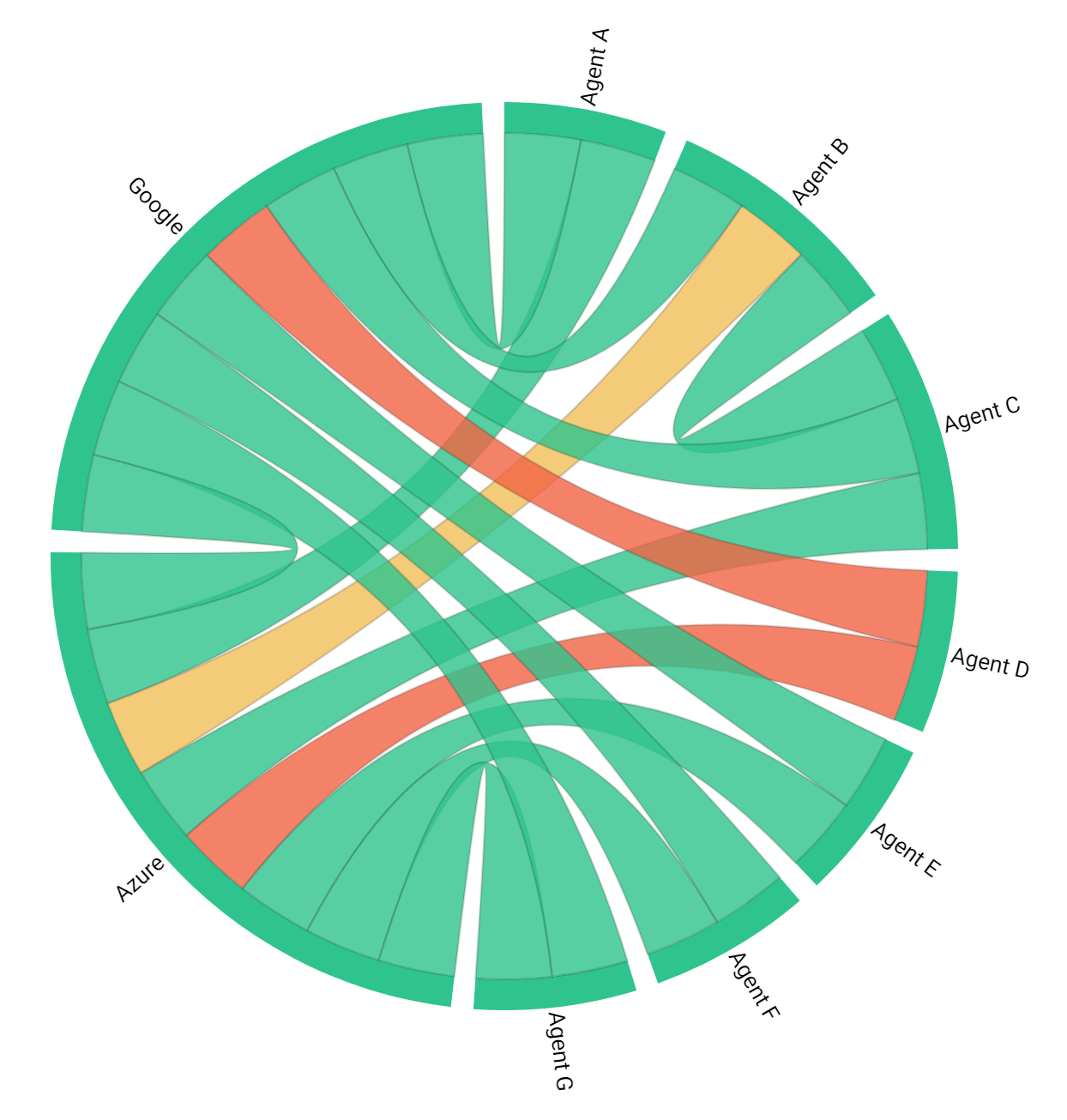
To conduct network performance testing using Obkio, it is crucial to configure monitoring agents in strategic network locations. These locations may include your workstation, the head office, branch offices, data centers, private clouds, public clouds, and more. Setting up monitoring agents in these key network locations allows for comprehensive and accurate assessment of network performance across your entire infrastructure.
- Local Agents: Installed in the targeted office locations where you want to test network performance. There are several Agent types available (all with the same features), and they can be installed on MacOS, Windows, Linux and more.
- Public Monitoring Agents: Deployed over the Internet and managed by Obkio. They compare and test network performance up to the Internet and quickly identify if the problem is global or specific to the destination. This will be great information for later in the troubleshooting process. You can use an AWS or Google Cloud Agent.
Set up your network performance testing for free with Obkio’s Free Trial.
Before beginning any network performance testing, it is important to define the goals and requirements of the testing. This helps to ensure that the testing is focused and effective.
The goals and objectives of network performance testing may vary depending on the specific needs and requirements of an organization. However, here are some common goals and objectives for network performance testing:
- Assessing Network Performance: The primary goal of network performance testing is to evaluate the performance of the network infrastructure. This includes measuring metrics such as bandwidth, latency, throughput, packet loss, and response time. By assessing network performance, organizations can identify areas of improvement and ensure that the network meets desired performance standards.
- Identifying Bottlenecks and Performance Issues: Network performance testing aims to identify bottlenecks and performance issues within the network. By simulating real-world scenarios and generating network traffic, testing can pinpoint areas of congestion, latency, or packet loss. This information helps in troubleshooting and optimizing the network to improve overall performance.
- Validating Network Upgrades and Changes: Network performance testing plays a crucial role in validating the impact of network upgrades, changes, or implementations. It helps ensure that proposed modifications to the network, such as new hardware, software updates, or configuration changes, will enhance network performance rather than degrade it. Validating upgrades and changes helps minimize disruptions and maintain optimal network performance.
- Meeting Service Level Agreements (SLAs): Organizations often operate under SLAs that define specific performance targets for their network. Network performance testing helps measure and validate compliance with these SLAs. By monitoring and assessing network performance against predefined metrics, organizations can ensure they are meeting their obligations and providing the expected level of service to customers or stakeholders.
- Supporting Capacity Planning and Scalability: Network performance testing aids in capacity planning and scalability. By evaluating current network performance, organizations can anticipate future needs and plan for network expansion or upgrades accordingly. Testing helps determine if the network has the capacity to handle increased traffic and data loads, ensuring scalability as the organization grows.
- Enhancing Network Security and Resilience: Network performance testing goes beyond speed and throughput; it also evaluates network security and resilience. By subjecting the network to stress tests, security assessments, and network risk assessments, organizations can identify vulnerabilities and weaknesses. This information enables proactive security measures to maintain data integrity, protect against cyber threats, and ensure network resilience in the face of potential attacks or failures.
- Proactive Issue Resolution: Network performance testing enables proactive issue resolution by identifying performance bottlenecks and areas for improvement. Early detection and resolution of issues help minimize downtime, improve and test network stability, and enhance user experience. Proactive testing also aids in identifying potential problems before they escalate, ensuring the network operates at peak performance levels.
These goals and objectives collectively contribute to optimizing network performance, ensuring a reliable and efficient network infrastructure, and meeting the needs of users and stakeholders.


Once you’ve deployed Obkio Monitoring Agents in key network locations, they will test and measure key network metrics. Measuring network metrics is crucial in network performance testing as it provides valuable insights into the performance, reliability, and efficiency of the network.
Measuring network metrics provides a solid foundation for identifying and resolving issues, ensuring a smooth user experience, and maintaining a high-performing network infrastructure.Here are some key network metrics you'll be testing:
- Jitter: Jitter is the variation in the delay of packet delivery in a network. In other words, it's the difference in the time it takes for packets to arrive at their destination. Jitter can cause issues with real-time applications such as voice over IP (VoIP) and video streaming. Network performance testing tools can measure jitter to help diagnose and troubleshoot network performance issues.
- Packet loss: Packet loss occurs when data packets are lost or dropped during transmission over a network. Packet loss can be caused by network congestion, faulty hardware, or poor network configurations. High packet loss can result in poor network performance and slow data transfer rates. Packet loss is an important metric for network performance testing as it helps to identify network issues that can impact overall network performance.
- Latency: Latency refers to the delay between the time when a packet is sent and when it is received. High latency can result in slow network performance, and can impact the user experience of applications such as video conferencing, online gaming, and VoIP (VoIP latency). Measuring latency is an important metric for network performance testing, as it helps to identify potential bottlenecks in the network that can impact overall performance.
- VoIP Quality: VoIP quality refers to the quality of voice calls over a network. Factors that can impact VoIP quality include latency, jitter, packet loss, and network congestion. Measuring VoIP quality with network and VoIP monitoring is an important metric for network performance testing, as it helps to identify network issues that can impact the user experience of voice calls.
- Throughput: Throughput refers to the amount of data that can be transferred over a network in a given amount of time. Measuring throughput is an important metric for network performance testing, as it helps to identify the maximum data transfer rate that can be achieved over a network.
- Network speed: Network speed refers to the maximum data transfer rate that can be achieved over a network. Network speed is an important metric for network performance testing, as it helps to identify the maximum performance that can be achieved over a network.
- And QoE: Quality of Experience (QoE) refers to the overall user experience of a network or application. Factors that can impact QoE include latency, jitter, packet loss, network congestion, and VoIP quality. Measuring QoE is an important metric for network performance testing, as it helps to identify network issues that can impact the user experience of applications and services.
And display them on Obkio’s Network Response Time Graph. Testing these network performance metrics allows you to proactively identify any performance degradation in your network, which may be a sign of a network issue arising, or an intermittent network problem in hiding.
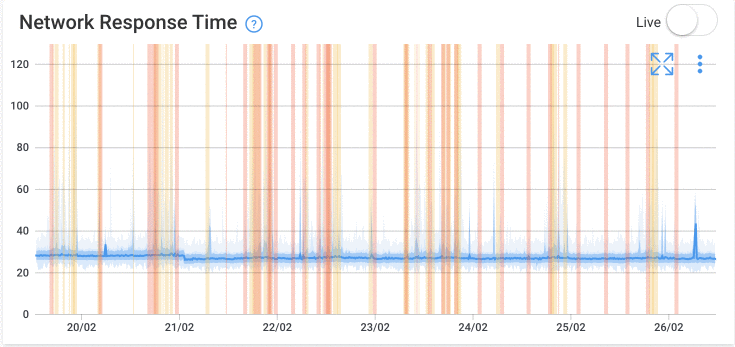

Network performance testing is particularly valuable when significant changes are implemented within a network. To effectively assess the impact of these changes, analyzing historical performance data becomes essential. By examining the network's performance before, during, and after the alterations to the infrastructure, organizations can gain insights into the network's behavior and identify any issues that arise.
Obkio simplifies this process by measuring and gathering historical network performance data on your behalf. This data enables you to analyze, compare, and troubleshoot past performance, empowering you to make informed decisions and ensure optimal network functionality.
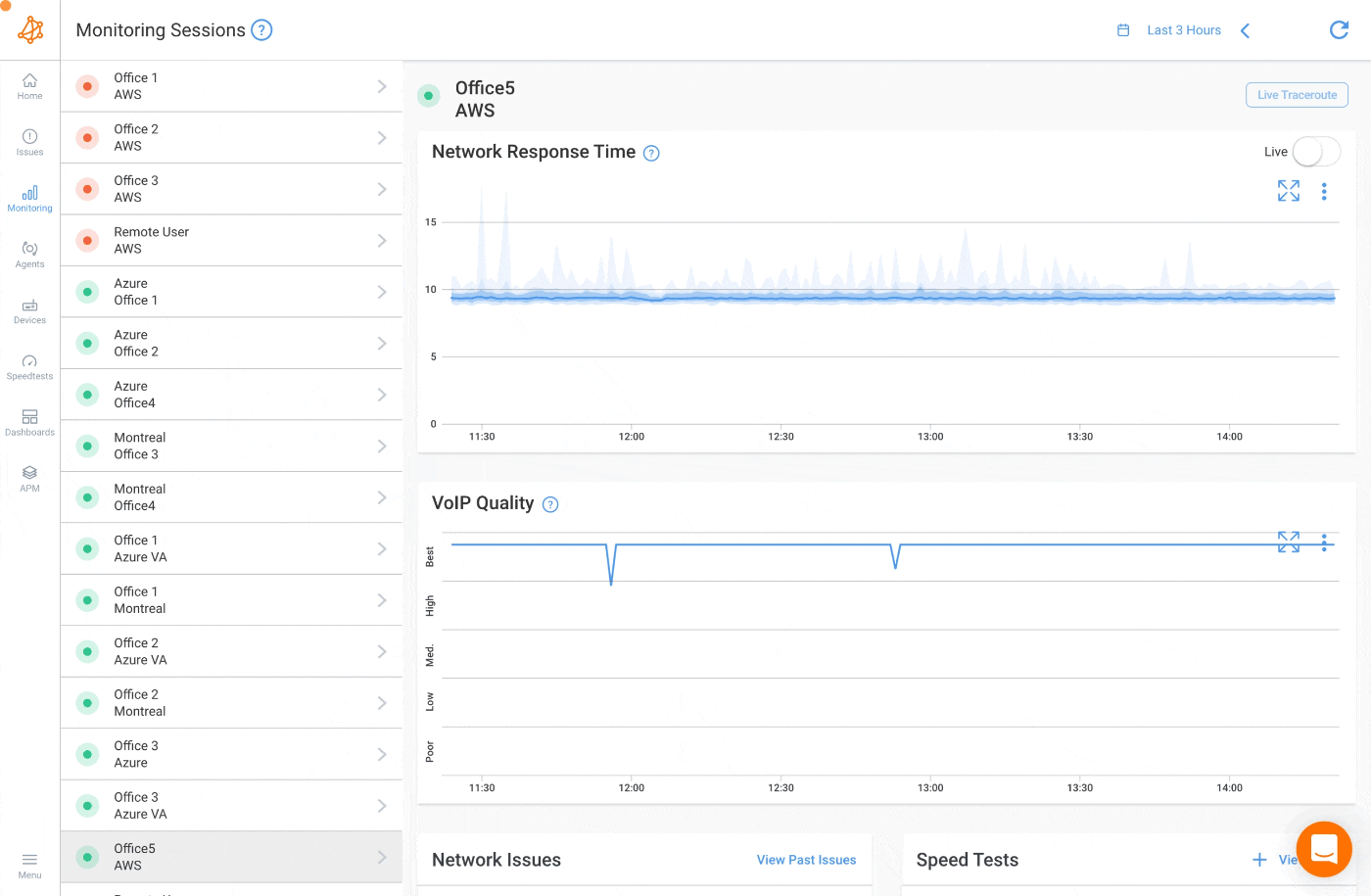
Go back in time to compare network performance before and after a new service migration or deployment, or pin a time range to find and troubleshoot intermittent network problems that pop up sporadically.
This also facilitates comparative analysis by testing different network configurations or changes. By comparing performance before and after specific modifications, it becomes possible to determine if the changes have introduced or resolved any issues. This helps in validating network upgrades, software updates, or configuration changes.
As previously discussed, network performance testing serves as a valuable tool for identify network issues or bugs that can occur even in high-performing networks. By implementing a comprehensive end-to-end testing and monitoring system, you can gather essential data to effectively detect and troubleshoot network problems.
This data-driven approach enables you to optimize network performance and ensure smooth operations. So, leverage the power of network performance testing to proactively identify and resolve any issues that may arise, paving the way for an optimized and efficient network environment.
Here are some of the most common network problems to test for:
- Network Slowness: Network slowness occurs when a computer network is operating at a slower-than-normal speed, often resulting in sluggish internet browsing or delays in accessing files or applications.
- Latency: Latency is the time it takes for a message to travel from one point on the network to another. High latency can cause delays and slow down network performance, making it harder for users to access data and applications.
- Packet Loss: Packet loss occurs When packets of data are lost or dropped during transmission. It can lead to retransmissions, which can slow down network performance and increase latency.
- Network Congestion: When there are too many devices using the same network resources, the available bandwidth can cause network congestion, cleading to slower network speeds and longer wait times.
- Packet Duplication: Packet duplication can occur when packets are duplicated during transmission, resulting in additional network traffic and potentially affecting network performance. When packets are duplicated, the receiving device may process the same data multiple times, leading to additional processing overhead.
- Packet Reordering: Packet reordering can occur when packets are received out of order. This can be caused by network congestion or delays in packet delivery. Packet reordering can cause additional processing overhead as the receiving device has to reorder the packets before processing them.
Network performance testing often involves real-time monitoring and network monitoring alerts that notify administrators of any network issues or deviations from expected performance. Obkio's Network Performance Monitoring tool will automatically alert you of events like packet loss between certain sites, or users experiencing high levels of jitter during VoIP calls, and more. This enables timely detection of network problems, allowing administrators to take immediate action to mitigate or resolve the issues.
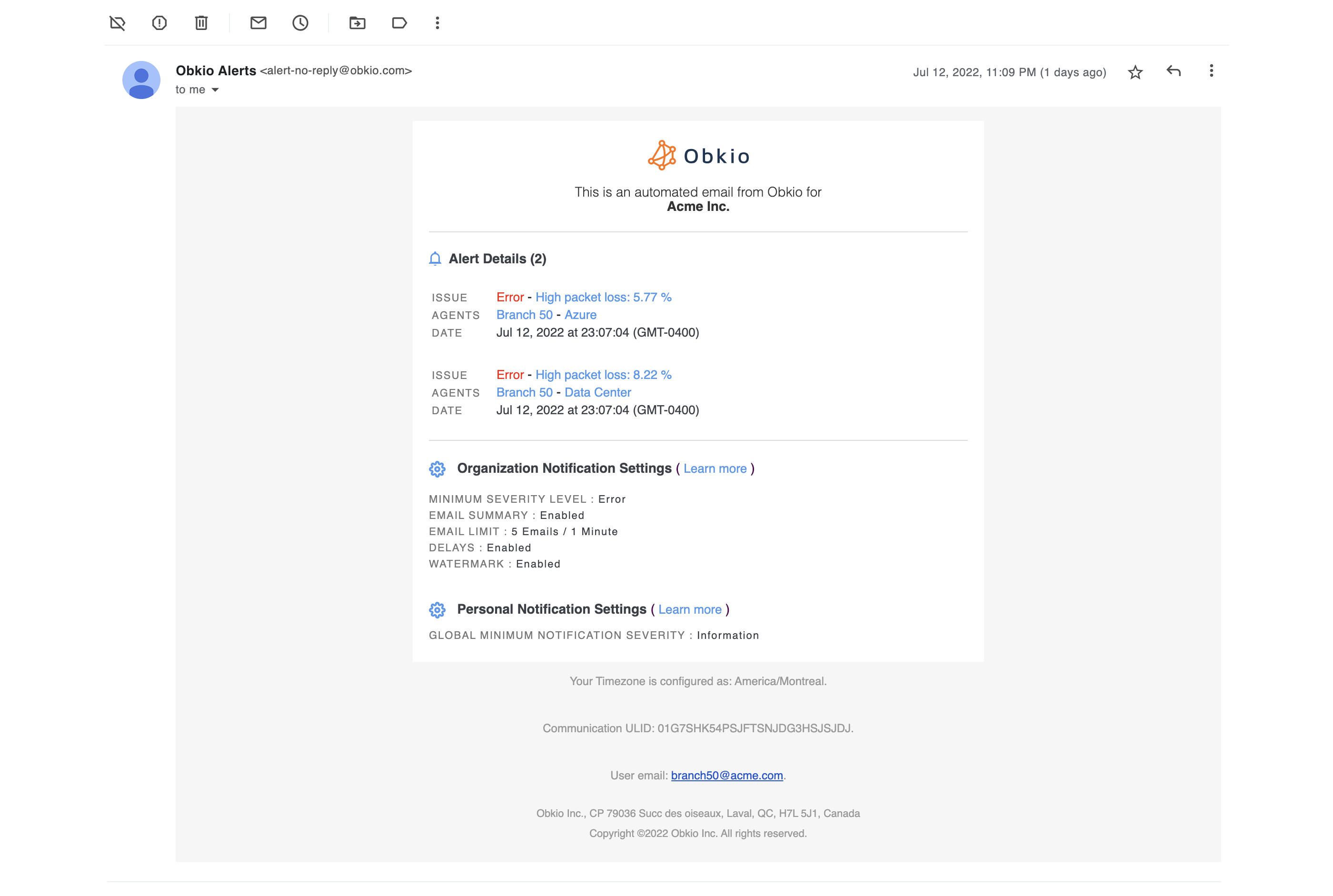
Network performance testing serves as a proactive approach to identify network issues by performing continuous tests and monitoring to identify network issues as soon as they happen. To identify the cause, source, time, and location of network problems, you can use network troubleshooting tools like:
- Traceroutes: Traceroutes are invaluable for pinpointing the route, latency, and packet loss between two network sites. They help identify the exact location and time when network problems occur. Obkio offers a Visual Traceroute tool that presents traceroute results in a user-friendly and interactive manner, enhancing the troubleshooting process.
- Speed Tests: Speed tests allow you to verify if the required bandwidth is readily available. By conducting speed tests, you can measure the actual upload and download speeds of your network connection. This information is crucial in determining whether the network meets the desired performance levels for your applications and services.
- Prioritization and QoS: Prioritization and Quality of Service (QoS) mechanisms optimize network efficiency, especially in cases of WAN or LAN congestion. By implementing prioritization and QoS policies, you can allocate network resources based on the criticality and sensitivity of different applications. This ensures that applications like VoIP (including VoIP PBX systems) and video streaming receive preferential treatment, reducing the impact of performance problems.
- Network Device Monitoring: Monitoring the health of network devices, such as firewalls, routers, switches, and Wi-Fi access points, provides detailed insights into their operational status. By monitoring these devices, you can identify potential issues, such as hardware failures, high CPU usage, or connectivity problems. This information helps in troubleshooting and maintaining the overall health and performance of the network infrastructure.
Learn how to troubleshoot network issues by identifying where, what, why network problems occur with Network Troubleshooting tools.
Learn more

Network performance testing is an invaluable tool for troubleshooting network issues. Here's how network performance testing with tools like Obkio helps in the troubleshooting process:
- Issue Identification: Network performance testing helps in identifying network issues by providing insights into performance metrics such as latency, packet loss, throughput, and network response time. By comparing the actual performance with expected benchmarks or predefined thresholds, deviations or anomalies can be detected. This information serves as a starting point for troubleshooting efforts, enabling administrators to focus on specific areas that require attention.
- Root Cause Analysis: Network performance testing allows administrators to conduct root cause analysis by examining the performance data collected during testing. By correlating network behavior with specific events or changes, administrators can identify the root cause of performance issues. For example, if network performance degrades after a recent configuration change, it suggests a potential misconfiguration as the root cause.
- Isolation of Problematic Components: Network performance testing helps in isolating problematic components within the network infrastructure. By conducting tests on different segments of the network, administrators can determine which components are causing the performance issues. For instance, if performance degrades only in a specific network segment or between certain devices, it helps narrow down the troubleshooting scope and focus efforts on those areas.
- Performance Baseline Comparison: Network performance testing involves establishing performance baselines by measuring network performance under normal conditions. When troubleshooting network issues, administrators can compare current performance metrics with the established baselines. Significant deviations from the baseline can indicate the presence of issues and provide insights into the magnitude and direction of the problem.
- Scenario Replication: Network performance testing allows administrators to replicate specific scenarios or user experiences that lead to performance issues. By recreating these scenarios in a controlled environment, administrators can observe and analyze the network's behavior. This helps in understanding the factors contributing to the problem and devising appropriate solutions.
- Validation of Solutions: Once potential solutions are identified, network performance testing can be used to validate the effectiveness of those solutions. By implementing the proposed fixes and retesting the network, administrators can determine if the performance issues have been successfully resolved. This iterative process ensures that the chosen solutions indeed address the underlying problems.
By leveraging network performance testing during troubleshooting, administrators can accurately identify, isolate, and resolve network issues. It provides data-driven insights, facilitates root cause analysis, enables the comparison of performance baselines, helps replicate problematic scenarios, and validates the effectiveness of proposed solutions. Ultimately, network performance testing minimizes downtime, improves network stability, and enhances overall network performance.
After testing your network performance, and identifying weaknesses, it's crucial to optimize network performance to ensure your network runs smoothly and meets your business needs. Below are some key strategies to consider:
- Troubleshoot network issues: Promptly resolving network problems can prevent them from affecting overall performance and ensure a smooth network operation.
- Verify network connections: Ensure that all network connections are correctly configured and functional. Check cables, routers, switches, and other hardware to ensure they are connected and configured properly.
- Upgrade network hardware: Updating network hardware can improve network performance. Consider upgrading to faster switches, routers, and servers, as well as increasing bandwidth and storage capacity.
- Optimize network settings: Fine-tuning network settings like packet and buffer sizes, and Quality of Service (QoS) settings can enhance network performance. Configuring QoS settings can prioritize essential traffic, reducing latency and improving user experience.
- Implement load balancing: Distribute network traffic across multiple servers to minimize server overload and enhance resource utilization. Network load balancing can reduce network congestion and minimize downtime.
- Use Content Delivery Networks (CDNs): CDNs deliver web content from the server closest to users, reducing latency and improving network performance.
- Implement Software-Defined Networking (SDN): SDN simplifies network management, control, and optimization, enhancing network performance and making your business more agile.
- Conduct regular network maintenance: Regular network maintenance, including monitoring network traffic, updating and patching, and keeping an eye out for potential issues, can prevent security threats and other issues that can affect network performance.

Regardless of the efficiency and successful troubleshooting of network performance issues, it's crucial to acknowledge that network problems can resurface at any time.
That's why continuous network performance testing is indispensable for optimizing network performance and aligning it with business requirements. To accomplish this, it is imperative to have a dedicated team and a robust solution that can consistently work towards optimizing the network.
That's why Obkio is here to be your full-time network admin!
By implementing network performance testing tools like Obkio, businesses can keep a permanent eye on their network, monitor network performance, and optimize it as needed. These tools can help businesses identify and address network issues promptly, prevent network downtime, and ensure that the network is running at peak performance.
- Early Issue Detection: Continuous network performance testing allows for the early detection of potential issues or bottlenecks in the network. By regularly monitoring performance metrics and conducting tests, organizations can identify emerging problems before they escalate into major network disconnections. This proactive approach enables prompt investigation and resolution, minimizing downtime and user impact.
- Performance Monitoring and Baseline Establishment: Continuous network performance testing provides ongoing performance monitoring, allowing organizations to establish performance baselines and track performance trends over time. By collecting historical data, organizations can identify patterns, spot anomalies, and track the effectiveness of performance optimization efforts. This data-driven approach helps in making informed decisions about network capacity planning, resource allocation, and infrastructure upgrades.
- Validation of Changes and Updates: Networks are dynamic environments that undergo constant changes, such as configuration updates, software upgrades, or the addition of new devices. Continuous network performance testing ensures that these changes are thoroughly validated before being implemented in the production environment. By conducting tests after implementing changes, organizations can assess the impact on network performance, identify any adverse effects, and make necessary adjustments or rollbacks.
- Capacity Planning and Scalability: Continuous network performance testing assists in capacity planning and scalability efforts. By regularly testing the network under different load scenarios, organizations can assess the network's capacity limits and determine when upgrades or expansions are needed to accommodate increased traffic or changing business requirements. This proactive approach helps organizations scale their network infrastructure to meet growing demands and ensure optimal performance.
- Performance Optimization and Troubleshooting: Continuous network performance testing supports ongoing performance optimization and troubleshooting activities. By consistently monitoring performance metrics, organizations can quickly identify performance degradation or anomalies, and take proactive steps to optimize network configurations, fine-tune settings, or troubleshoot issues. This iterative process allows for continuous improvement of network performance and enhances the overall user experience.
- Compliance and SLA Management: Continuous network performance testing helps organizations meet compliance requirements and manage Service Level Agreements (SLAs). By regularly monitoring performance metrics and conducting tests, organizations can ensure that their networks meet the defined performance standards and comply with regulatory guidelines. It also enables them to proactively address any potential service or Internet SLA violations and take corrective measures to meet contractual obligations.
In conclusion, network performance testing is a critical component of maintaining a high-performing network infrastructure. By testing, monitoring, and optimizing network performance, you can ensure that your network meets the demands of your business and provides a seamless user experience.
With a plethora of network performance testing tools available, it's important to choose a solution that offers comprehensive features, ease of use, and reliable support. That's where Obkio comes in!
Obkio provides a powerful and user-friendly platform for network performance testing, allowing you to effortlessly monitor, analyze, and optimize your network. Whether you need to identify issues, troubleshoot problems, or maximize performance, Obkio has got you covered.
Don't settle for subpar network performance. Take the leap towards peak performance with Obkio today! Visit our website to learn more and start optimizing your network like never before.

To set up network monitoring to test, diagnose, and troubleshoot your network -
- 14-day free trial of all premium features
- Deploy in just 10 minutes
- Monitor performance in all key network locations
- Measure real-time network metrics
- Identify and troubleshoot live network problems

Remember, a well-tested network is a high-performing network. Embrace the power of Obkio and unlock the full potential of your network performance!












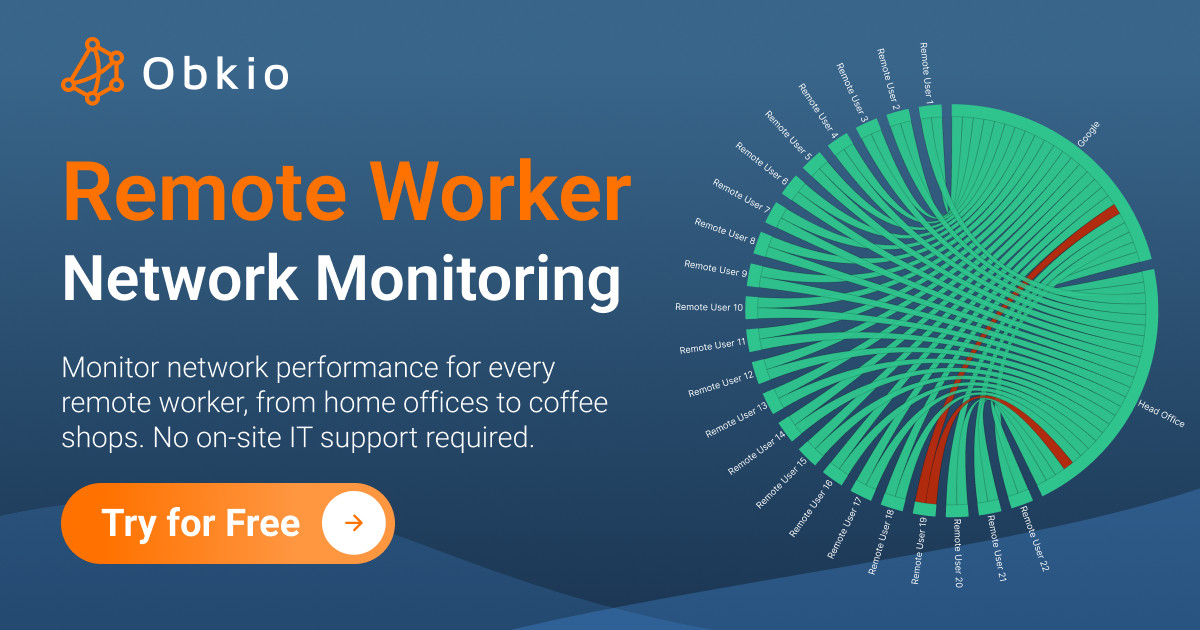













 Obkio Blog
Obkio Blog




